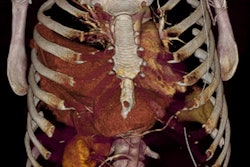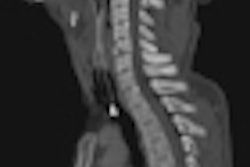
Is whole-body CT being used appropriately in emergency department (ED) trauma patients? It's hard to tell and dangerous to generalize, but strategies and utilization differ considerably in the U.K., even though the use of whole-body CT scans for trauma cases is generally rising, according to the results of a new survey published in the Emergency Medicine Journal this month.
Less than one-fourth of emergency departments had a specific policy on the use of whole-body CT, while another quarter used the technique on certain cases without a strict policy, the study team wrote. There was some concern about after-hours care as well, during which cases may be reviewed by less experienced staff, especially in smaller centers without utilization policies, which generally took longer to report their findings (Emerg Med J, August 2012, Vol. 29:8, pp. 630-634).
Most emergency departments saw fewer than one trauma case per day, making whole-body scan decisions rare. The findings raise some concern about the delivery to provide adequate care, especially out-of-hours, wrote Drs. Christopher M. Smith and Suzanne Mason from Health Services Research, School of Health and Related Research in Sheffield, U.K.
"Clearly, hospitals performing whole-body CT need tried and tested mechanisms to ensure the timely delivery of an accurate and checked report to ED doctors and, when needed, specialty doctors," they wrote. "There are misgivings about the use of [whole-body CT]."
There are several concerns, of course, one being that whole-body CT involves more radiation exposure than radiography or targeted CT, they wrote. Estimates place the excess lifetime risk of fatal cancer from a single scan at between 1 in 1,000 and 1 in 2,000. Any follow-up scans increase the dose even more, and delays due to whole-body CT scanning may even delay definitive management of the patient's injuries.
Even though decision surrounding use of the technology are critically important, there seems to be little consensus in the literature about the best way to use whole-body CT and which patients it is most likely to benefit. Therefore, the study aimed to investigate the current use and nature of whole-body CT policies in U.K. emergency rooms.
The study team created and mailed questionnaires to managing physicians in 245 emergency departments in the U.K. in 2010. Ten of the centers did not treat major trauma patients, and ultimately 184 of the remaining 235 returned the forms after two additional rounds of questionnaires were sent out in June and July to nonresponders, Smith and Mason wrote. The results were as follows:
Most responding emergency departments (152/184) saw one or fewer trauma patients per day, and only six centers had 24-hour radiologist consultants present, the team reported. All but one of the 174 centers had 24-hour access to CT, while 178 (96.7%) had an alert policy for trauma patients.
Just 22.3% (41/184) of respondents said they had a whole-body CT policy for trauma patients, and there were regional variations. Two centers communicated they had a policy in development, and 43 indicated they used whole-body CT without a formal policy for doing so.
EDs that saw more than one patient per day (14/32) were more likely to have a whole-body CT policy than centers that saw fewer than one patient per day (27/152, odds ratio [OR] 3.60, 95% confidence interval: 1.60 to 8.12, p = 0.0039). There was a significant association between the increasing number of patients seen and the presence of a whole-body CT policy (p = 0.0006).
Of the 45 departments responding that they used whole-body CT without a formal policy, 36 provided information on the criteria used to image patients, with all but one center citing multiple criteria.
Consultant radiologists were available in most hospitals (178/184, 96.7%) during the day, while 133 out of 184 hospitals (72.3%) stated that a radiologist was usually available in the overnight hours.
Reports were prepared within one hour during regular hours in 173 out of 183 (94.5%) centers and in 161 out of 183 (88.0%) during off hours. No significant differences in reporting time were seen between hospitals with and without whole-body CT policies during regular hours. However, there was a significantly increased likelihood of longer reporting times during off hours for hospitals without a policy.
"Most EDs saw less than one 'trauma' case per day ... so for many EDs it is likely that decisions regarding whether or not to carry out [whole-body CT] would not be made very often," Smith and Mason wrote. In a related finding, very few departments (3.26%) had a 24-hour radiology consultant presence, and none of the emergency departments with whole-body CT policies had 24-hour consultant presence, a situation that "might feasibly impact upon the requesting and performing of whole-body CT out of hours," the study team wrote.
"Efforts are being made to increase consultant presence in the ED and expand the consultant workforce, which may be particularly relevant as the majority of severely injured patients do, in fact, attend ED out of hours," the authors noted.
Most higher-volume centers had a policy for whole-body CT use, and previous studies have shown higher-volume centers to provide a higher standard of care. "We do not suggest that the presence of a [whole-body CT] policy is the reason for improved care for trauma patients, rather that a policy may be present more often in centers with better systems in place for dealing with the multiply injured patient," they stated.
The finding that many centers using whole-body CT do not have a policy covering its use was unexpected. On a positive note, most centers with whole-body CT policies had multiple criteria for its use, in line with studies in other parts of Europe. No center used mechanism of injury alone as the criterion for whole-body CT, and most centers said they would provide lifesaving interventions before scanning the patient, according to the authors.
"The role of the radiologist should not be underestimated when considering the need [for whole-body CT]," they pointed out. "Close cooperation will be needed when making requests, and the timely recognition and reporting of injuries may be important to a patient's progress. Increasing specialization might necessitate the development of a 'trauma' radiologist to interpret different types of injury accurately across several different body regions."
The finding that most reports were produced within an hour was encouraging; however, "accurate reporting is more important than early reporting," the authors wrote. On the other hand, delays in reporting for centers without a whole-body CT policy were somewhat concerning, and it's clear that hospitals performing whole-body CT need robust mechanisms to ensure the timely delivery of radiology reports, they wrote.
"Plans to set up regional trauma networks with a small number of hospitals acting as major trauma centers are under way nationwide," they wrote. "It will be interesting to see if the nature of [whole-body CT] use changes when these networks are fully operational. If a small number of major trauma centers are receiving all of the 'significant' trauma, should it be just these centers that are offering whole-body CT?"
The study showed that less than one-fourth of U.K. emergency departments have a whole-body CT policy, and patient selection varies widely. "The survey has further highlighted concerns about how effectively [whole-body CT] can be delivered, particularly out of hours," they concluded.



















